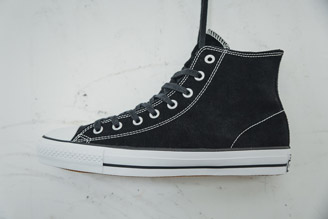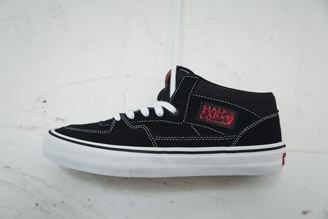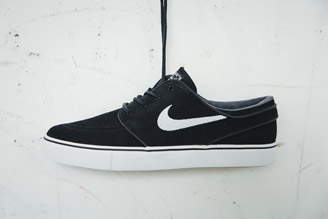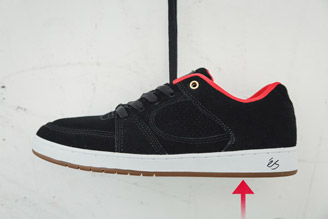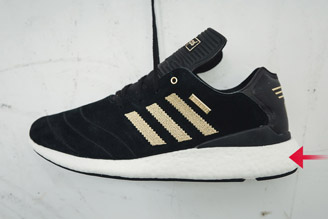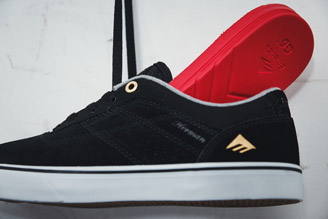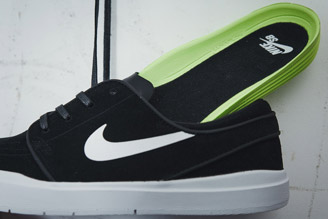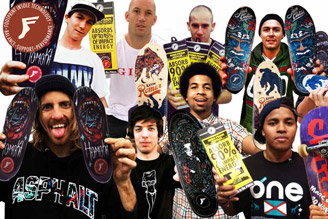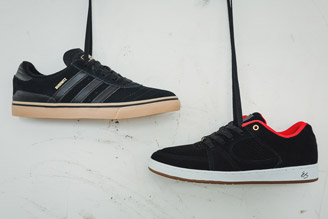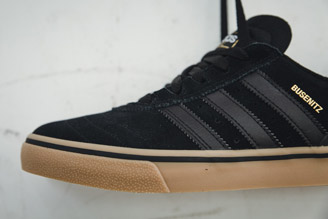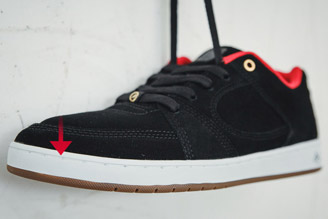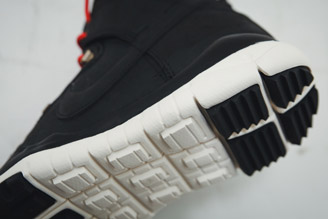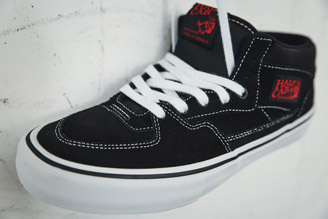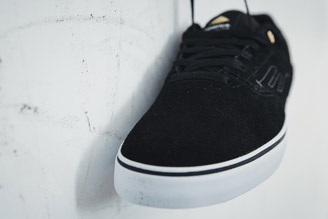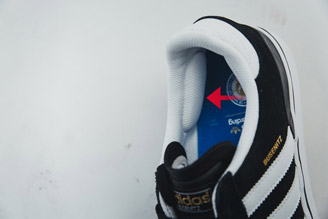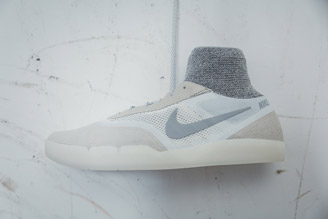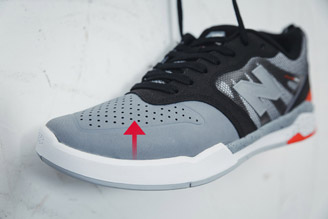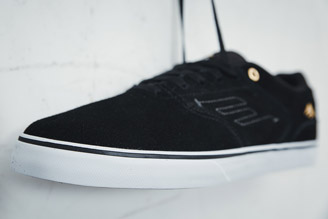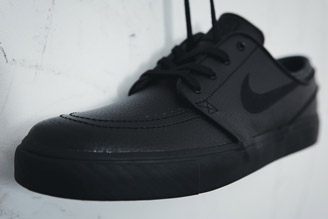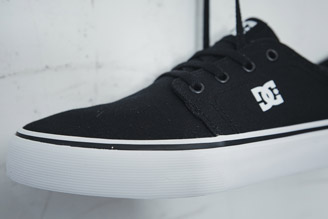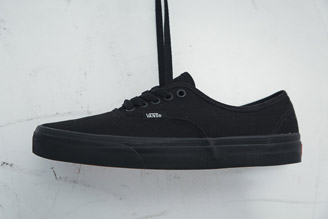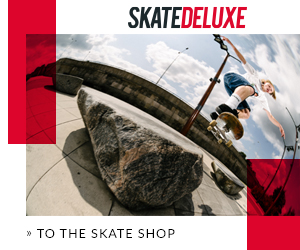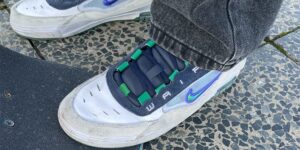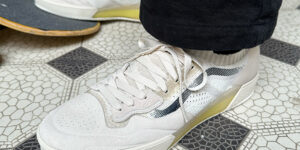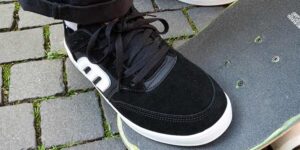Skate Shoes and Sneakers
To help you find your way through the labyrinth of cup and vulc soles, from low, mid, and high-top sneakers, and technical developments like Hyperfuse, Flynit, and Duracap so you can find the perfect pair of shoes, we’re shining some light on the most important features, terms and characteristics of skate shoes and sneakers.
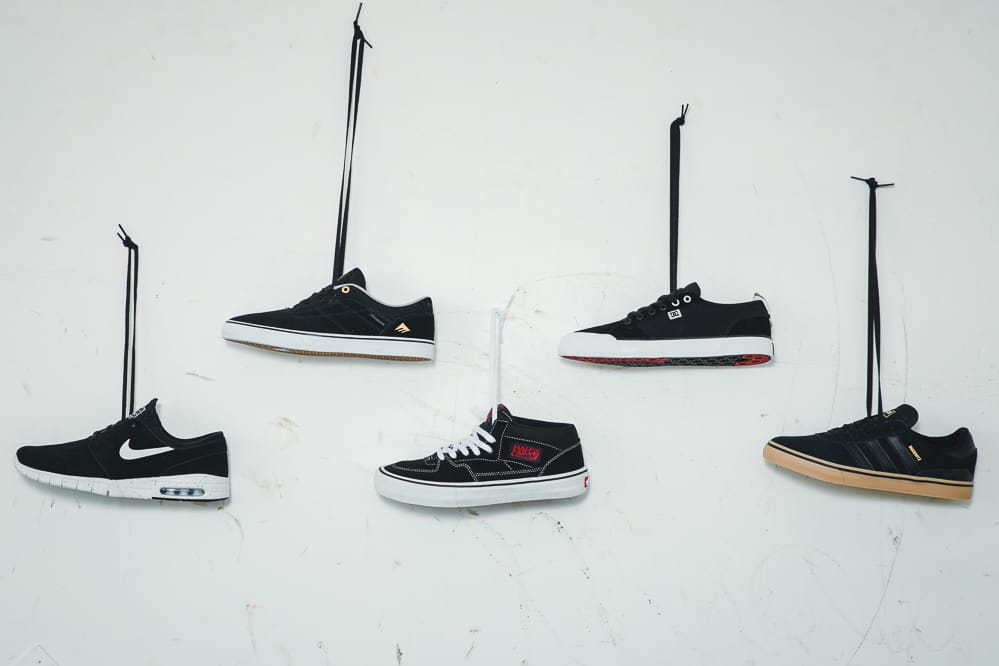
What are the different materials used? Are there different fits? How can you reduce wear on your shoes and how do you take care of your shoes best?
Here you can find answers to your questions as well as some tips.
1. Types of Shoes
High, Mid, Or Low Cut Shoes? The agony of having to choose between style, comfort, taste and feel.
Basically, the three types of shoes differ in the height of the shaft. Easy! Let us distinguish the individual types from one another:
High-Tops are higher cut than other shoes. They usually end above the ankle. Thanks to the higher cut, high-tops offer more stability as well as additional padding and thus, more safety, protection and cushioning in the area of your ankles and ankles.
Additionally, higher cut shoes will keep you warmer. This can be an advantage when skating to keep your joints warm. However, they don’t breathe very well. Some high-top sneakers are also suitable as winter shoes because of their high cut.
High-Top Skate Shoes and Sneakers
If you can’t decide between high-tops and low-tops, but you definitely want more stability and padding, mid-top shoes are exactly what you need.
Mid-Tops are slightly higher cut than low-cut shoes, and the laces typically fall just under or directly at the ankle. They’re not as high as hi-top shoes, but they’re higher than low-tops. As a result, they offer a higher degree of stability, dampening, and support as compared to low-cut sneakers. Additionally, most mid-tops are perfectly suitable as “transitional shoes” in the colder months of the year because they stay warm and dry.
Mid-Top Skate Shoes and Sneakers
Low-Top shoes are the flat standard models in the world of skate shoes and sneakers. Thanks to their lower cut, these models are usually more lightweight.
You lose the padding in your ankle area in favour of the lighter weight and material. But don’t worry, thanks to highly developed insoles, you don’t have to sacrifice cushioning and dampening.
Low-Top Skate Shoes and Sneakers
2. Shoe Soles
What do the different types of shoe soles mean?
The construction and texture of the sole are responsible for the comfort and feel of your shoe. Different soles are built into the same shoes to meet all the different requirements. Here you can find out more about the various kinds of soles and how they differ from each other.
The outsole is the most important component of a good skate shoe. It has to fulfil all of your wishes for grip, stability, and flexibility and must also be resistant to abrasion. In order to optimally meet all these needs, air-pads and other types of shock-absorbent cushioning are often integrated into the outsole.
Between the outer and inner sole lies the midsole. This is the main dampening component of the shoe and is made mostly of EVA (ethyl vinyl acetate) as well as phylon, a heat-resistant plastic. Almost all of the major shoe labels have developed their own midsole constructions. The most well-known are the Lunar Footbed, the Max Air and Zoom technology from Nike, the adidas Skateboarding BOOST soles (as seen on the left) and the Etnies STI Evolution Foam as well as the DC Unilite Soles. You can learn exactly what each technology entails in our skate shoe wiki page.
With insoles, it’s all about the individual needs of the wearer. This is why they’re often removable or interchangeable in higher-priced shoe models. So once they’re worn out, you can replace the insoles or if they’re not as fresh as they once were, you can let them air out.
There are many models that offer diverse features. For extra cushioning, gel pillows are sewn into certain insoles. The curvature of an insole is also adapted to suit the needs of skaters. Depending on the brand and model, there are different types of skate shoe insoles. The foot bed is often made of EVA, a heat-resistant man-made material that’s both soft and elastic as well as durable. There is also the Ortholite Insole. It’s a breathable and antibacterial insole that cools and is particularly long-lasting and resilient. Some insoles rely on dual-density. They have varying degrees of firmness throughout the footbed and provide even more comfort when you’re moving.
There are also shoe inserts that are specifically fabricated for skateboarders. These provide even more dampening, which helps protect against injuries and relieve your joints. At skatedeluxe you’ll find Footprint Insoles, which is probably the best-known manufacturer for optimised removable insoles. There’s a good reason why skateboarders like Aaron “Jaws” Homoki, Andrew Reynolds and skatedeluxe team rider Willow rely on insoles from Footprint.
Special insoles at skatedeluxe
When it comes to skate shoes, a distinction is made between two different sole constructions: cup sole and vulcanised sole. Cup soles are sewn into the shoes, making them more robust, but at the same time, also somewhat heavier and more inflexible. Shoes with a vulcanised sole offer a lot of agility and a great feel for your skateboard, but they are less robust than shoes with a cup soles due to the fact that they don’t have the additional seams. Here you’ll learn exactly what these sole constructions entail in detail:
Vulcanised Soles
The greatest advantages of skate shoes with vulcanised soles are the lower weight and the higher flexibility thanks to a thinner sole. Such a sole construction results in an incredible board feel. Because, in contrast to the cup sole, the individual rubber parts are only glued to each other in vulcanised soles and adhered to the upper by a narrow rubber strip. This means you can jump on your board as soon as you get your shoes, without having to break them in first. The downside of this manufacturing process is that vulcanised shoes wear through relatively quickly and are more prone to abrasion. They also don’t dampen as well as cup soles on account of the fact that they’re thinner and softer.
Skate Shoes & Sneakers with Vulc Soles at skatedeluxe
Cup Soles
The cup sole consists of three main parts: an outsole, a midsole made of highly elastic and lightweight foam, and a separate insole. The outsole is comprised of one piece. It is glued to the midsole securely at the upper and additionally sewn into the shoe, while the insole is either glued in or simply inserted. Due to the thick polyurethane sole and extra seam, a shoe with a cup sole is more stable and better at damping than a vulcanised sole, especially if you’re skating gaps and steps. Due to the thick soles, however, these shoes are also heavier and less flexible than vulcanised soles and therefore take longer to be broken in.
Skate shoes & sneakers with cup soles at skatedeluxe
Depending on the manufacturer, there are different shoe profiles that give both cup soles and vulcanised soles more flexibility, cushioning, board feel or grip. Among the best-known are the Herringbone profile and Waffle sole, which was exclusively developed for skateboarding by Vans. Nowadays, the trend is steadily moving in the direction of ultralight soles, such as the Nike Free sole, which is perfect for both sneakers and after-skate shoes. Soles with thicker profiles are mainly used in winter and outdoor shoes to provide the necessary grip in snow and wet conditions.
skate shoes & sneakers with profile soles
3. Shoe Features
What makes skate shoes so special?
Tearing at the seams – every skater is familiar with it. That’s why the seams are such a vital component of skate shoes. Skate shoes are characterised by the fact that the seams in the more vulnerable areas of the shoes are specially reinforced and thus significantly reduce wear and tear. Of course, even the best-sewn shoe isn’t immune to wear and tear over time. Nevertheless, the shoes should have double or even triple seams in the toecap and heel areas, because these spots wear through quickly due to the griptape.
If you use a really rough griptape, however, you won’t be able to enjoy your shoes for very long, despite three and four-fold seams. If that’s the case, we recommend a seamless toecap. These shoes are totally free of any interfering seams in the front toe area, and not only prevent blowouts but also make for a comfortable flick (the snappy foot movement to make your board rotate). Nonetheless, it is important to note that not every shoe is additionally reinforced at this spot, which is why seamless toe caps tend to be more frequent.
When skating, your feet, ankles and joints are constantly subjected to severe stress. In order to reduce the impact of harder tricks, like when jumping gaps or stairs, many skate companies equip their shoe models with various forms of upholstery. In skate shoes, the tongues, heel areas, side walls as well as some other areas are often padded in order to prevent injuries and increase the comfort while skating.
Everyone knows them, no one loves them – sweaty feet. Especially when skating, your feet can get really sweaty. That’s why optimal ventilation is the key when it comes to the comfort and feeling of your shoes.
Thanks to perforations (breathing holes) and breathable upper materials, fresh air can be circulated and help prevent moisture. In addition, some manufacturers build perforated side panels and vent holes directly into the sides of the shoes or use tongues made of airy mesh material.
There are shoelaces in countless colours, lengths and shapes. Unless you prefer velcro straps on your shoes, laces are the simply the ultimate feature. But here, too, there are a few differences between traditional street shoes and skate shoes. Because not only do the upper materials and soles wear out quickly due to the griptape but the shoelaces take a beating as well. Therefore, a waxed or leather shoelace is a very clever alternative. Metal or plastic eyelets, as well as special shoelace protectors, also increase the life of your laces enormously.
Skate shoe laces at skatedeluxe
4. Materials
Which materials are skate shoes and sneakers made of?
Not all leathers are the same, which is why you’ll find little tags or stickers in every shoe with the legally determine material labels. This consists of small pictures or symbols, which tell you exactly which materials are used.

The fun of skating depends largely on the durability of your shoe. Therefore, the outer material of skate shoes is one of the most important features. Most models are made of suede because it’s particularly tough. In addition, it is stretchy and softer with frequent use, which means that you can opt for a tighter-fitting suede shoe and then break it in to get a perfect fit, impeccably formed to your foot. If the entire shoe isn’t made of suede, they should definitely have it on the heavily stressed spots, like the ollie area and toecaps. Suede is used in the industry as a basic term for any leather with a rough surface, produced directly from the softer underside of animal hide.
Suede skate shoes & sneakers
As opposed to suede, patent leather is produced from the top, outer layer of animal hide and is generally thinner and consequently less durable. Patent leather (aka coated leather) usually comes with a coloured layer or an additional artificial coating.
Patent leather skate shoes & sneakers
Are you totally against the use of animal materials? That’s cool too! Because there are some great alternatives to the various leather options. Many shoes are made of textiles. As such, canvas is typically used to create leather-free skate shoes. Sure, canvas isn’t quite as wear-resistant as leather, but it’s still a durable alternative. The advantages of sneakers made of textiles are the reduced weight and the increased breathability. Textiles include all woven, knit and bound materials. These include natural fibres (animal and plant products such as wool or flax), and synthetic fibres (e.g., viscose or nylon). You’ll also recognise the special symbol for shoes made of textile materials.
Canvas skate shoes & sneakers
Go vegan! This includes shoes now too because the skateboarding industry is striving to offer more sneakers that are manufactured without the use of animal products. Even the adhesives are considered, which is why most brands now use water-based glues.
Vegan skate shoes and sneakers
5. Passformen
Which types of shoes fit which kinds of feet?
In addition to all the technology, the most important thing is that you like the shoes and that the ones you want to wear actually fit you. We’ve all heard something like this at some point: “You’ll grow into them!” Or “They’re not too tight; you just have to break them in!”
What should you consider when searching for the perfect fit for skate shoes and sneakers?
In principle, your shoes shouldn’t be so big that you swim in them, but they shouldn’t be so small that they constrict your feet on the sides or toe area. The rule of thumb: there should be a small space, about the size of the width of your thumb. This should give you enough space and ensure that the shoes don’t constrict you. With a little more space in the front area, you’ll also have the option to use additional insoles to increase the damping and comfort. Many prefer an exact fit especially for skating so that your feet sit firmly in the shoes. This increases the feeling for your skateboard and for tricks, for instance in the flick for kickflip variations.
If you have small feet and don’t really know what type of shoe is right for you, then you should know that extra wide and chunky shoes probably aren’t your best bet. Some models end up looking stocky due to the limited size, which makes them less stylish. In addition, your feet may feel lost in thicker shoes. For smaller, narrower feet, less cushioned low-top shoes are the most suitable. But, of course, this is always subject to your individual preferences, and the distinct feel you’re going for. If you feel most comfortable in thickly padded high-top shoes, then you should wear them and skate, of course.
Larger feet are usually also narrower than smaller ones. This is why there are also narrow cut sneakers and skate shoes. With big feet, even clunky and wider shoes look narrow(er) and somehow also (even more) stylish. It is up to you, which type of sneaker you prefer to wear if you have big feet, but a slightly narrower fit seems to be recommendable.
If your feet are rather narrow, you should not necessarily go for wide, chunky shoes, because then your feet often feel a bit lost. Many manufacturers offer narrower and less cushioned shoes. These usually come in a low-top variation.
If your feet are rather wide, you probably won’t have any fun with narrow-cut shoes, because these can be uncomfortable on the toes and ankles. Even if you think your shoes will stretch out after a while, you can do without the pain at the beginning. So look for shoes with a wide toe cap and your toes will thank you because especially when skating, a lot of pressure is put on your forefoot every time you land.
You can easily see the cut of the skate shoe by looking at the soles, which is always shown in the product pictures at skatedeluxe. A wider cut shoe is not too tight around the arches, so it is suitable for wider feet. A narrower shoe is tighter around the middle, and offers a more stable fit and healthier stance, but can be uncomfortable if you have somewhat wider feet.
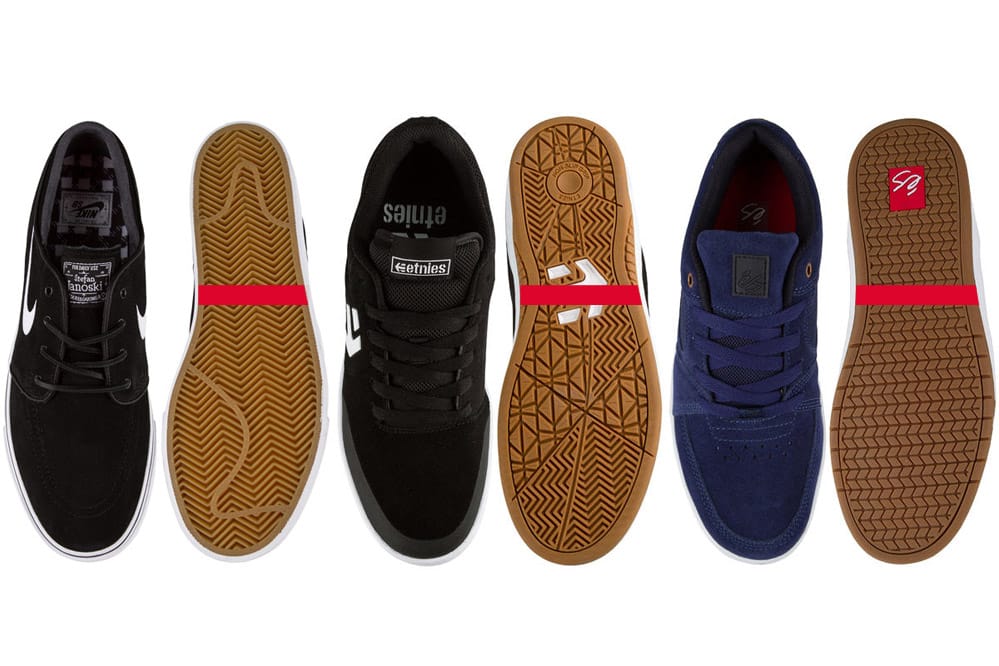
6. Sizing
Different brands, different sizes
When purchasing new skate shoes, you should keep in mind that shoes differ fundamentally and that the sizes and conversions from US to EU and UK are not standardised. In order to help you find the right shoe size, we have included size tables from different brands and their own conversions and have incorporated them into our size chart.
If you are not familiar with US sizes, you can easily switch to EU or UK sizes. If you’re still not sure which size you need, just contact our customer service. Our service team is happy to help.
7. Wear & Tear Prevention
In order to help you enjoy your new sneakers and skate shoes for a long time, we’ve put together a few tips for you:
✔ Make sure that your shoes are always neatly laced to avoid slipping and tripping. Even if you enjoy the chilled look and feel of loose laces, both your shoes and your joints suffer from it. Always keep them tied up tightly! This not only protects the outer sole and interior of the shoes, but your bones as well. ✔ You should always properly tie and untie your shoes when putting them on and taking them off; don’t just try and slip them off. The padding, reinforcement in the heels, as well as the seams of your shoes will thank you. ✔ The extreme demands on your shoes in bad weather can also be reduced by using conventional waterproofing spray. This protects the material and keeps your feet dry even in wet conditions. Whether for prevention or to stop holes from getting any larger – with different adhesives, you can prevent or counteract further wear on your shoes. Simply apply it to the appropriate spot, smooth it out, and allow it to harden and you can take on your next skate sesh without damage.
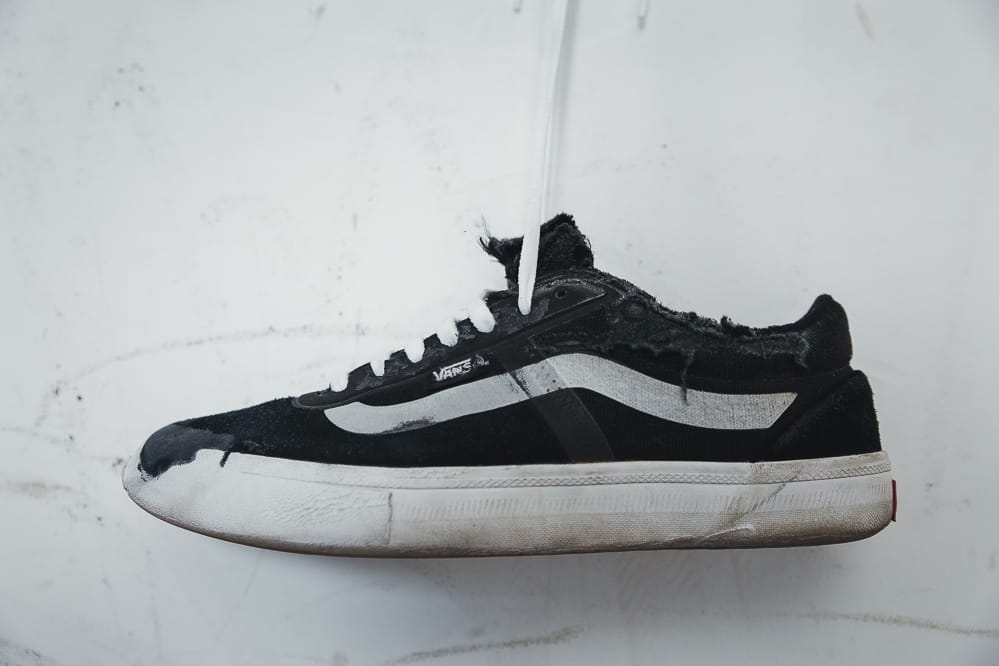
✔ Due to constant contact with griptape, shoelaces tear very quickly. It is also worthwhile to apply a small amount of the glue to the exposed areas to protect your laces. The use of adhesives is particularly prudent when it comes to skate shoes made of canvas or sneakers that are made of textiles. ✔ After intense sessions, we recommend that you air out your skates properly. This way, you not only reduce unpleasant odours, but it also gives your kicks a break, which extends their shape stability. ✔ Do not use detergents with aggressive ingredients such as alcohol, acetone, etc. as this can lead to discoloration and damage to the adhesive and waterproofing. ✔ Putting shoes into the washing machine is an absolute no-go! Your shoes may seem clean on the outside, but you totally ruin the padding, coating and adhesives. In the worst case, your shoes will deform and end up being absolutely un-skateable.
8. Care Instructions
Of course, shoes also need care – not just for style reasons, but also to extend their lifespan. Dirt, moisture and sweat are a daily tribulation for your shoes, so it is worth taking care of them.
To do so, you should follow a few basic rules:
✔ Clean your shoe with a soft brush or a damp cloth so that you don’t put too much strain on the material. ✔ You should dab with a rag rather than trying to scrub. Otherwise, you’ll just work the dirt deeper into the upper material. This is often the case with canvas or mesh sneakers. ✔ The outer sole is best cleaned with clear water or a light detergent such as curd soap or hand wash paste. ✔ Daily street dirt and dust can easily be removed with standard wet wipes.
9. Glue and repair skate shoes
Despite the best care, signs of wear and tear on skate shoes are unavoidable. Especially the upper material and the sole on the toe and side area are particularly stressed when skating. In order to prevent rapid wear or to repair wear and tear that has already occurred, you can “glue” skate shoes.
The special shoe adhesives can be used individually for leather, rubber, vinyl, canvas and other materials that can be found on shoes. They reinforce the heavily stressed areas and repair them again. Here we show you how it all works:
To the Ripcare shoe repair glueWas your question not answered here? Or is something still unclear to you? Just contact the girls and guys on our customer service team. They can definitely help you out!

